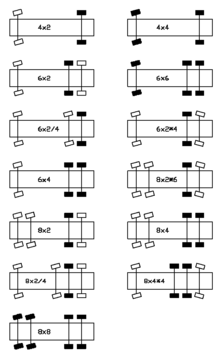Wheel formula
The wheel formula (also called axle configuration) is an indication of the total number of wheels of a non-rail-bound land vehicle , the number of driven wheels and the number of steered wheels.
formula
The formula is:
A × B / C
or.
A × B * C
With:
- A = number of wheels ( twin tires count as one wheel)
- B = number of driven wheels
- / = the front wheels of the rear axle package are steered (leading)
- * = the rear wheels of the rear axle package are steered (trailing)
- C = number of steered wheels
The basic configuration is based on the standard configuration in which the front axle (s) are steered and the rear axle (s) are not. This means: if only the front wheels are steered, the rear part of the formula is omitted. The best-known example is probably the 4 × 4 wheel formula , which is known from off-road vehicles . 6 × 4/4 is the wheel formula for a vehicle with 6 wheels, 4 of which are driven. In addition, the 2 front wheels and the wheels of the front of the two rear axles are steered. In this case it is a three-axle vehicle.
The formula A × B × C is also often used. Even if the specification of C is actually superfluous, this only means that only the front axles are steered and thus provides information about the distribution of the axles. For example, the manufacturer's specification 8 × 4 × 4 means that of four axles, two at the rear are driven and two at the front are steered. However, this specification overlaps with the 6x2 / 2 configuration, which describes a three-axle vehicle in which the front axle is steered and in which the rear of the two rear axles is driven (with a 6x2 the front of the two rear axles would be driven). The slash indicates the leading rear axle, but it is preceded by the number of steered wheels.
See also
swell
- Josef Epker: Trucks and Technology. Epjos Verlag, 2014. ISBN 9783981651300
